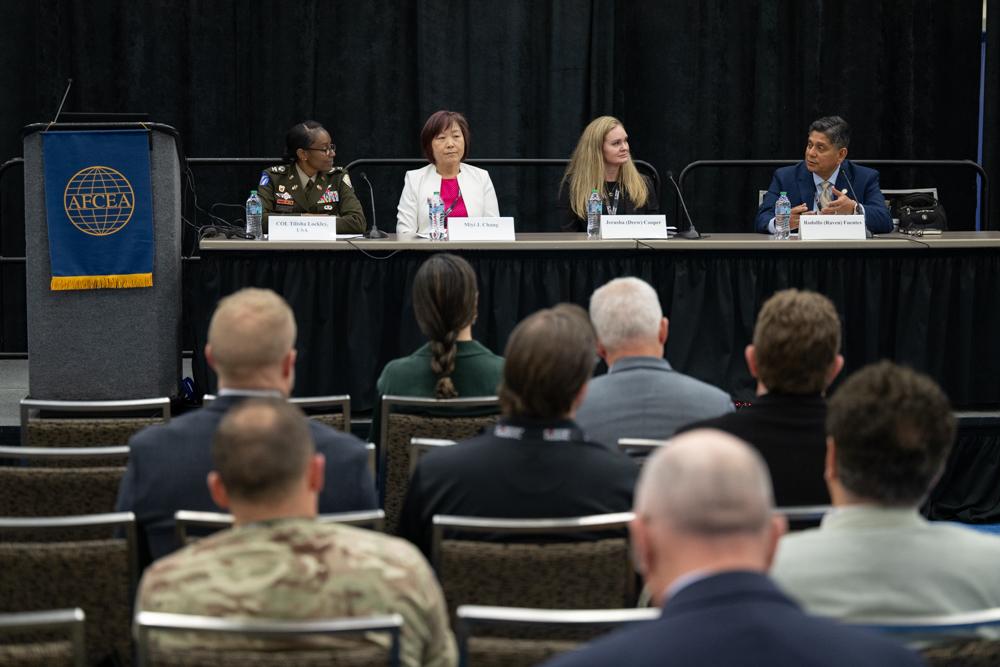DISA Official: CJADC2 Was Never Meant To Be Siloed
The combined joint all-domain command and control, commonly referred to as CJADC2, initiative was not created to be siloed for each theater, subject matter experts from the Defense Information Systems Agency (DISA) stated. An enterprise solution does not yet exist, however.
The panel discussion on the first day of TechNet Cyber 2025 consisted of moderator Col. Tilisha Lockley, USA, commander at DISA Europe; Miyi Chung, technical director at DISA Pacific; Jerusha (Drew) Cooper, technical director at DISA Global; and Rodolfo (Raven) Fuentes, technical director at DISA Europe.
The purpose of CJADC2 is to enhance information delivery and decision advantage for commanders. The addition of the word “combined” to “JADC2,” which was an update formally made just two years ago, was to underline partnership collaboration
“Combined, joint, all domains, it is meant to be enterprise, and it is meant to be global,” Chung told the audience. “Because we have not delivered that enterprise solution, each theater is implementing its own flavor of CJADC2.”
As an example, Chung offered, the IndoPacom theater created its own kill chain joint fires network. Additionally, “because there isn’t a zero-trust mission partner environment, IndoPacom developed its own IndoPacom mission network,” she said.
“We need to stop developing these siloed applications tailored to each theater because they’re only doing it because an enterprise solution does not exist today,” Chung emphasized.
Through collaborative work, however, common understanding is possible, Cooper highlighted. “The trade-offs of us working in our own stovepipes creating our own thing is honestly, we create multiple answers to the same problem,” she said. “If you’re not working together to solve the problem, then you have five dashboards with a different answer for each, so then what’s your source of truth at that point in time? I think that’s definitely part of the problem.”
There’s an additional challenge that comes with data standards and quality, she added. “That problem amplifies when you create something on your own and then try to bring it together later. That might seem like a quick win in the short term, but it ends up taking longer to get after those common operational pictures,” Cooper said.
Working within each others’ common problem spaces offers significant advantage, she noted.
Subsequently, the officials spoke on zero-trust implementation.
“Zero trust is our foundation,” Fuentes emphasized. “We need this in order to ensure we can focus on micro segmentation, continuous modern capabilities as well as least privilege access, and you can’t do that without applying some type of zero-trust architecture within our cloud environments.”
Zero-trust implementation will allow for further collaboration with mission partners, as well as non-NATO nations, Fuentes added. “Ultimately, it’s important for us to understand that there’s a lot of information that’s going to be needed to provide that appropriate common operational picture that each combatant command has been asking for for dozens of years. This is the time for us to go ahead and deliver that.”
Another topic of discussion was the reduction of latency for CJADC2. Chung shared the steps being taken within the Indo-Pacific command theater.
“In order to build a common operating picture, we need to have connectivity to be able to access the information,” Chung stated. Building a more resilient Defense Information Systems Network, also known as DISN, is part of the equation, she added. “The way we’re doing that is we’re leveraging all undersea cable systems available. We’re trying to build agnostic transport gateways so that we can leverage even the commercial transport.”
Additionally, the Indo-Pacific theater has implemented the joint operational edge cloud node, also referred to as JOE Node, Chung said. “Bottom line is, as stated before, we have a lot of cloud capabilities on CONUS [Global Operations Command], but we need to bring the data closer into the proximity of the four deployed units."
Chung shared that commercial edge devices have been deployed and are operational in two data centers today, with many onboarded applications across the joint services.
Furthermore, she stated, the theater is enabling compute and storage processes in the case of complete disconnection from the CONUS region. Such operations are key in maintaining decision superiority, Chung said.
“In terms of applying zero trust, we really haven’t done that other than implementing a security-as-a-service edge device router connecting to the [joint operational edge cloud node], and what that would do is it would enable some sort of [software-defined wide area network], enabling a lot of agnostic transport means of transmission to connect, but we haven’t really implemented zero-trust principles within our JOE architecture,” Chung stated.
DISA is however partnering with the DOD chief information officer as well as the Air Force Mission Partner Environment office, Chung continued. “We are beginning to spearhead the implementation of a classified cloud environment, leveraging zero-trust principles to enable different trust levels of access.”
As degrees of cybersecurity maturity vary across different allies and partners, DISA cannot apply the same amount of trust for all. “We have to come up with different means of enabling the trust-based security architecture so that we can enable our allies to access the data—that must have data—so we can make risk shared decisions together by looking at the same data points and visualizing the same battlespace,” Chung said.
Ultimately, industry is vitally important for CJADC2 success, all speakers agreed. "We definitely now have the technology and the right people in the right place," Cooper stated, adding that having industry on the team would be largely beneficial.
Chung also noted the need for vendor agnostic solutions, mentioning artificial intelligence model agnostic solutions for plug-and-play capability.
"We need your help in developing CJADC2 on the global scale so that we can all communicate with each other and that we're not siloed," Fuentes added.
TechNet Cyber is organized by AFCEA International. SIGNAL Media is the official media of AFCEA International.






Comments